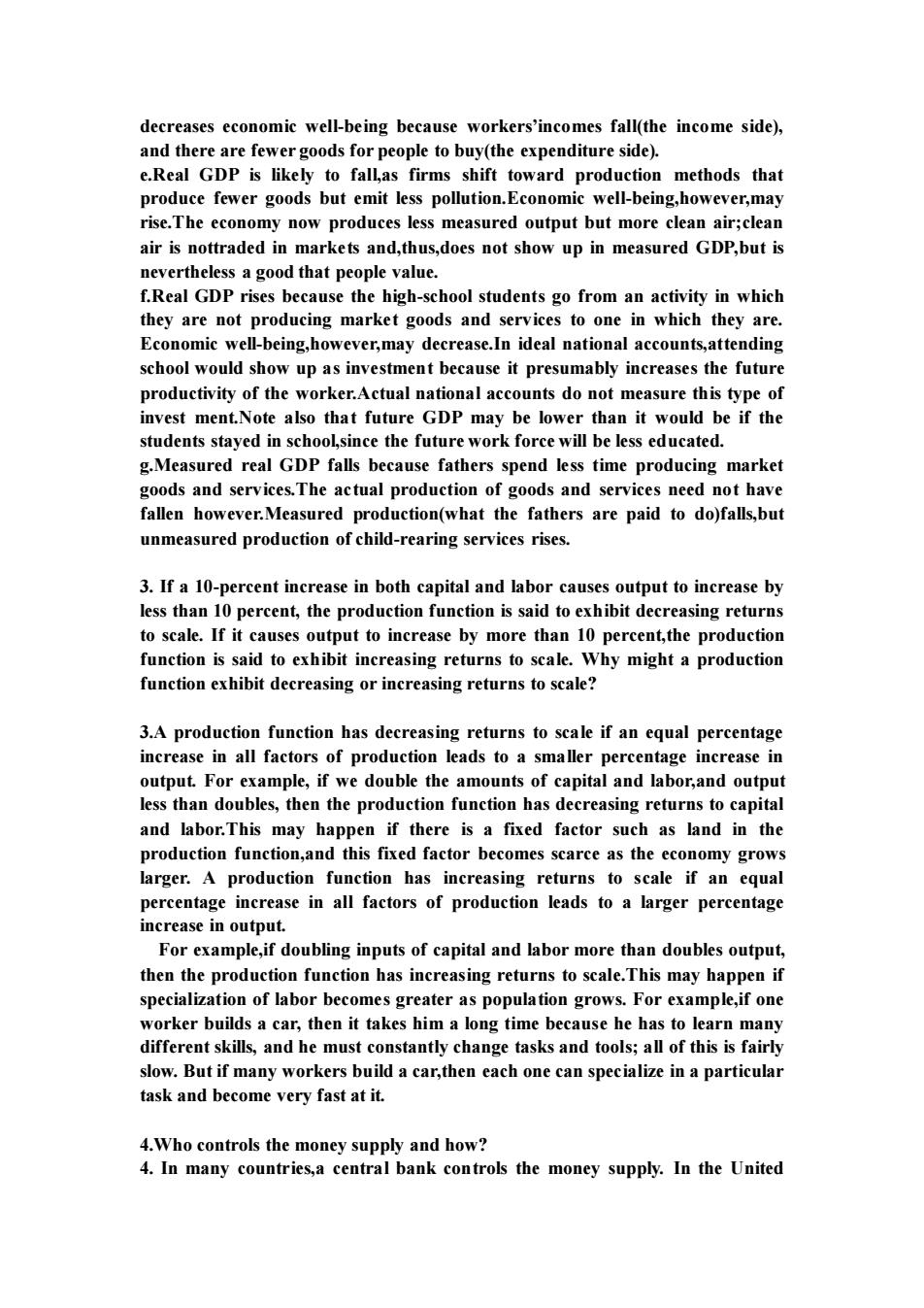正在加载图片...

decreases economic well-being because workers'incomes fall(the income side), and the oods fo people to b (the expe diture side). e.Real GDP is likely to fall,as firms shift toward production methods that produce fewer goods but emit less pollution.Economic well-being,however,may rise.The economy now produces less measured output but more clean air;clean air is nottraded in markets and thus does not show up in measured gDP.but is evertheles od that people value high- chool students go from an activity in which they are not producing market goods and services to one in which they are Economic well-being,however.may decrease.In ideal national accounts attending school would show up as investment because it presumably increases the future invest me t.N hat future】 GDP ma lowe th it would be if the lents stayed in s 100 ince the future work force will be less educated g.Measured real GDP falls because fathers spend less time producing market goods and services.The actual production of goods and services need not have fallen however.Measured production(what the fathers are paid to do)falls but unmeasured produc tion of child-rearing services rises 3.If a 10-percent increase in both capital and labor causes output to increase by less than 10 percent,the production function is said to exhibit decreasing returns to scale.If it causes output to increase by more than 10 percent the production function is said to exhibit increasing returns to scale.Why might ap pr ion exhibit de creasing or i ncreasing returns t to scale? 3.A production function has decreasing returns to scale if an equal percentage increase in all factors of production leads to a smaller percentage increase in output.For example,if we double the amounts of capital and labor,and output less than doubles then the pro duction fu on has de to e and labor.This s may happen if there is a fixed factor such h as land in the production function,and this fixed factor becomes scarce as the economy grows larger.A production function has increasing returns to scale if an equal percentage increase in all factors of production leads to a larger percentage increase in For example,if doubling inputs of capital and labor more than doubles output then the production function has increasing returns to scale.This may happen if specialization of labor becomes greater as population grows.For example,if one worker builds a car,then it takes him a long time because he has to learn many different skills,and he must constantly change tasks and tools;all of this is fairly slow.But if ma orke alize in a particula task an d become very fast at i 4.Who controls the money supply and how? 4.In many countries,a central bank controls the money supply.In the United decreases economic well-being because workers’incomes fall(the income side), and there are fewer goods for people to buy(the expenditure side). e.Real GDP is likely to fall,as firms shift toward production methods that produce fewer goods but emit less pollution.Economic well-being,however,may rise.The economy now produces less measured output but more clean air;clean air is nottraded in markets and,thus,does not show up in measured GDP,but is nevertheless a good that people value. f.Real GDP rises because the high-school students go from an activity in which they are not producing market goods and services to one in which they are. Economic well-being,however,may decrease.In ideal national accounts,attending school would show up as investment because it presumably increases the future productivity of the worker.Actual national accounts do not measure this type of invest ment.Note also that future GDP may be lower than it would be if the students stayed in school,since the future work force will be less educated. g.Measured real GDP falls because fathers spend less time producing market goods and services.The actual production of goods and services need not have fallen however.Measured production(what the fathers are paid to do)falls,but unmeasured production of child-rearing services rises. 3. If a 10-percent increase in both capital and labor causes output to increase by less than 10 percent, the production function is said to exhibit decreasing returns to scale. If it causes output to increase by more than 10 percent,the production function is said to exhibit increasing returns to scale. Why might a production function exhibit decreasing or increasing returns to scale? 3.A production function has decreasing returns to scale if an equal percentage increase in all factors of production leads to a smaller percentage increase in output. For example, if we double the amounts of capital and labor,and output less than doubles, then the production function has decreasing returns to capital and labor.This may happen if there is a fixed factor such as land in the production function,and this fixed factor becomes scarce as the economy grows larger. A production function has increasing returns to scale if an equal percentage increase in all factors of production leads to a larger percentage increase in output. For example,if doubling inputs of capital and labor more than doubles output, then the production function has increasing returns to scale.This may happen if specialization of labor becomes greater as population grows. For example,if one worker builds a car, then it takes him a long time because he has to learn many different skills, and he must constantly change tasks and tools; all of this is fairly slow. But if many workers build a car,then each one can specialize in a particular task and become very fast at it. 4.Who controls the money supply and how? 4. In many countries,a central bank controls the money supply. In the United